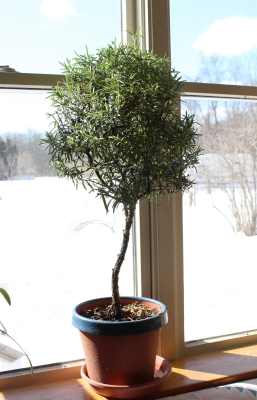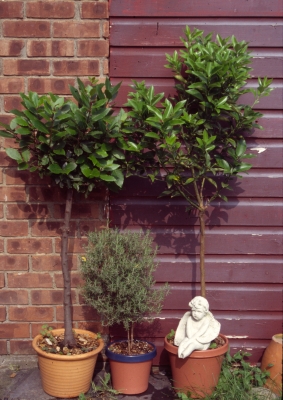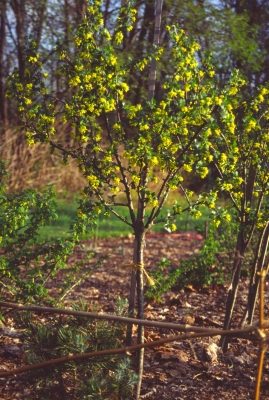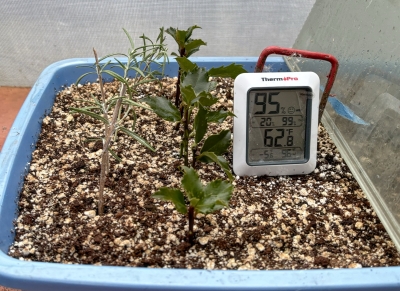Looks like I’ve done it again. Killed rosemary, the plant. Worse than that, I’ve killed two rosemary plants. And even worse still, drawing on my experiences killing numerous rosemary plants — perhaps you also have killed one or more — I’ve been dispensing my “expertise” on how not to kill rosemary.
My reasoning went like this: Although native to the generally dry climate of the Mediterranean region, roots of rosemary plants in the ground there can reach far and wide in their explorations for water. Not so for rosemary plants that need to live in pots here, where winters are too cold for them outdoors.
To make matters worse, rosemary’s stiff, needle-like leaves don’t signal that the plant is crying out from thirst by wilting. The leaves just sit there on the stems looking perky until, if the soil has been too dry for too long, the leaves still hold their place and shape but take on a bluish cast. At this point the stems will rain down dry leaves if accidentally or purposely brushed against.
Dry needles don’t necessarily signal that a plant is dead. But it might be. I’ve revived near-dead plants with timely watering. In fact, one of the two recent deaths was a revival.
Why Did My Rosemary Die?
Rosemary is a popular herb grown by many gardeners for its fragrant, pine-like flavor and hardy nature. However, even this sturdy Mediterranean plant can struggle and die if its growing needs aren’t met If your rosemary starts turning brown and dying back, don’t give up on it just yet! Here are the most common reasons rosemary dies and tips to revive your plant
OverwateringThe number one killer of rosemary is overwatering. Rosemary’s roots need good drainage and lots of oxygen. They quickly suffocate in wet soil leading to root rot. Check that the soil is drying out completely between waterings. Add organic material like bark chips to improve drainage. Repot potted plants in containers with adequate holes if needed.
Underwatering
While rosemary handles drought well, severe dehydration will still damage the plant. Brittle, dry foliage that snaps when bent signals the plant urgently needs water. Drench the soil deeply when the top few inches are completely dry. Water potted plants until water flows from the bottom drainage holes.
Insufficient Sunlight
As a Mediterranean herb, rosemary thrives in full sun and needs at least 6 hours of direct daily light. Too much shade results in minimal fragrance and lackluster growth. Place rosemary in the sunniest spot or supplement with grow lights.
Frost Damage
Rosemary is extremely vulnerable to frost and cold damage. Even a few hours below 25°F can injure or kill the plant. Cover plants to protect them from frost or move containers indoors. Prune away dead sections, leaving 1⁄4 inch above live growth.
Excessive Heat
While heat-loving overall, rosemary suffers without adequate water and airflow if temperatures exceed 100°F consistently. Ensure rosemary gets 1-2 inches of water per week during hot spells. Mist leaves to cool the plant. Increase shade and air circulation.
Improper Pruning
Pruning into rosemary’s woody centers can damage the plant. Only tip prune young, green growth. Over-pruning stresses rosemary. Always leave plenty of healthy leaves and stems intact after pruning.
Pests and Diseases
Spider mites, mealybugs, whiteflies, root rot, and powdery mildew can attack weakened rosemary. Promptly remove diseased material. Treat with neem oil or organic pesticides. Introduce beneficial insects that eat pests.
Age
Rosemary can live over 10 years with care. But eventually the plant becomes woody and starts declining. Propagate new plants from cuttings for replacement before the original dies.
Poor Soil
Rosemary needs a loose, fertile soil with a neutral to slightly alkaline pH around 6.5-7.0. Mix compost into heavy clay or sandy soils to improve drainage and nutrients. Test and amend pH if needed.
Transplant Shock
Rosemary doesn’t tolerate root disturbances well. Always move rosemary with its root ball intact if possible. Temporarily shade transplants. Ensure transplants get mycorrhizae fungi to aid nutrient uptake.
Sudden Environment Changes
Sudden variations in light, temperature, humidity or exposure quickly stress rosemary. Transition indoor rosemary slowly over 7-10 days before moving it outside. Provide shade for outdoor plants moved indoors.
Root Bound
If left in the same container for too long, rosemary’s roots choke each other as they expand. Repot root bound plants in larger containers with loosened roots. Propagate replacements if rosemary fails to recover.
By identifying and fixing the underlying issue, you can often revive struggling rosemary. But catch problems early before damage becomes irreversible. Growing rosemary in ideal conditions greatly reduces plant stress and mortality. With a little TLC, your rosemary can thrive for years to come.

But . . .
Giving more thought to RDS (Rosemary Death Syndrome) may absolve me of some of the blame. Sure, desiccation will kill rosemary, just as it will kill any plant. Rosemary just doesn’t cry for help along the way.
I grow rosemary as “standards.” Quoting from this chapter of my pruning book (The Pruning Book), “Standard” has many meanings . . . [it’s] a naturally bushy, small plant trained to have a clear, upright stem capped by a mop of leaves. A miniature tree. I count myself among standardophiles and, if I may speak for the group, we like standards for their neatness and because they have the lollipop shape of storybook trees. “Standard” does seem like an odd word to describe such a plant until you realize that . . . “standard” . . . [comes] from the Old English words standan, meaning to stand, and ord, meaning a place.

Naturally bushy plants are bushy because they send up new sprouts from ground level and/or sprawl over the ground often rooting wherever a stem touches the ground. But bushy plants don’t have long-lived stems. If they did, those stems would become trunks. And that’s the “formal wear” into which I’ve always forced my rosemaries.
I’ve had similar experiences with other plants. Years ago I trained a red currant bush into an attractive espalier. The plant protested as I kept pruning back any sprouts trying to grow up from or near ground level. I got the upper hand and eventually had a single trunk capped, at a height of about three feet, by two permanent arms running in opposite directions along the top of my garden fence. It was a sight to behold each July when the translucent berries dangled down like jewels along the arms. The “trunk” eventually got old and the plant died.
I similarly trained some clove currants, these plants for their very fragrant trumpets of yellow flowers. Clove currant, which sends runners and stems arching to the ground all over the place, is even less inclined to be tree-like than red currant. The three little “trees” were beautiful while they lasted.

The point is that bushy plants don’t have long-lived trunks, and these plants vary in just how long their stems can remain vigorous. My two rosemary standards evidently came to the end of their line.
New Plants on the Way
Fortunately, lots of people don’t grow potted rosemaries as standards. I was able to get some stems from a friend with which to make new plants.
Also fortunately, rosemary is relatively easy to root. I took some semi-woody shoots and stripped off most of the lower leaves, then plunged the bases into a mix of equal parts peat moss and perlite. Warm roots and cool air would be ideal, as would be some rooting powder, but all that’s not a necessity. I have a heating mat to provide, at least, bottom warmth to foster root formation.
The cuttings do need some kind of covering to maintain high humidity until roots form. Clear plastic, either a bag or inverted tub, does the trick. The setup needs to be in bright light so leaves can photosynthesize to feed growing roots, but out of direct sunlight or else they’ll cook.
Soon I’ll have new rosemary plants on their way to standard-dom.
One other thought: Perhaps I overcompensated with watering my two rosemary plants. Too much water can also kill a rosemary plant, most cultivated plants in fact.
Why Is My ROSEMARY PLANT DRYING? (3 REASONS and How to AVOID IT)
FAQ
How do you revive a dying rosemary plant?
You need to cut all the dead stuff away and repot into a well draining soil. Water very little daily until you notice new growth. Then switch to watering once a month, if that. These are in the class of plants that require abuse and neglect to survive. They are pure masochists.
Why did my rosemary die suddenly?
Rosemary plants have roots that don’t like wet conditions. So, overwatering is one of the main reasons for root rot or loss of plant parts. Root rot eventually leads to the death of the plant. Winter can be detrimental to the rosemary plant. This evergreen herb likes hot and dry weather for its growth.
Does rosemary grow back if it dies?
-
Rosemary’s Growth Habit:Rosemary is a woody shrub, and unlike some plants, it doesn’t readily regrow from old, woody stems.
-
Signs of a Dying Plant:Look for signs of a dying plant, such as leaves turning dark and brittle, or the stem starting to mold.
-
Reviving a Near-Dead Plant:
- Check for Green Stems: If you see any green stems, there’s a chance the plant can be revived.
- Prune Back: Cut back the plant to the green stems, encouraging new growth.
- Take Cuttings: If you want to ensure a healthy plant, take cuttings from the rosemary and try to root them.
- Provide Warm Roots and Cool Air: Rosemary thrives in warm roots and cool air.
- Use Rooting Powder: Consider using rooting powder to encourage new growth.
- Maintain High Humidity: Cover cuttings with clear plastic to maintain high humidity.
- Bright Light, Not Direct Sunlight: Place the cuttings in bright light, but out of direct sunlight.
- Check for Green Stems: If you see any green stems, there’s a chance the plant can be revived.
-
Starting Over:If the rosemary plant is too old or leggy, it’s often best to start with new cuttings or seedlings instead of trying to rejuvenate it.
Why is rosemary so hard to keep alive?
However, maintaining a rosemary plant indoors can be a little tricky. During the winter, warm and dry air inside homes can wither its leaves and desiccate the twigs. Rosemary needs cool and moist conditions in wintertime, as well as a good amount of sunlight (or artificial light that doesn’t emit heat).
Why do Rosemary plants die?
In this article, we discussed the common reasons why rosemary plants die. We learned that rosemary plants can die from a variety of causes, including overwatering, underwatering, pests, diseases, and transplant shock. We also learned how to identify the signs of a dying rosemary plant and how to prevent and treat problems.
Can Rosemary die from overwatering?
Rosemary is a hardy and even drought-tolerant plant once established so more often than not, in our attempts to give our plants the right conditions, it will be overwatering that will cause your rosemary plant to die. Rosemary plants don’t like to sit in soggy wet soil, so it’s important not to overwater them.
Why is my Rosemary turning brown and dying?
If your rosemary is turning brown and dying, there could be a number of different reasons it’s happening. Rosemary plants are hardy plants, but they can still fall victim to certain pests and diseases. In this article, gardening expert and former organic farmer Logan Hailey shares the most common reasons for a brown, dying rosemary plant.
How to prevent a Rosemary plant from dying?
Let’s conclude on how to prevent a rosemary plant from dying. You should provide them with well-drained sandy soil and at least 6-8 hours of sunlight (10-12 hours is optimal). Since rosemary plants are drought tolerant, water them when soil mostly dries out. Avoid overwatering the plants as this will cause pest and disease problems.
How do you know if a Rosemary plant is dying?
A: There are a few signs that your rosemary plant is dying. These include: Wilted leaves: The leaves of your plant will wilt and droop if it is not getting enough water. In this article, we discussed the common reasons why rosemary plants die.
Why is my Rosemary rotting?
Rosemary plants have roots that don’t like wet conditions. So, overwatering is one of the main reasons for root rot or loss of plant parts. Root rot eventually leads to the death of the plant. Winter can be detrimental to the rosemary plant. This evergreen herb likes hot and dry weather for its growth.
